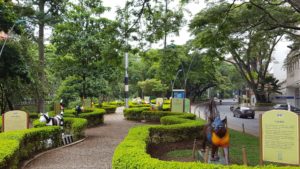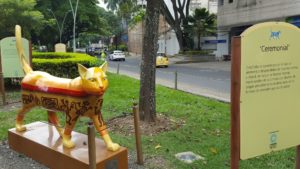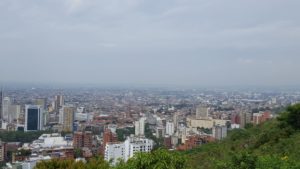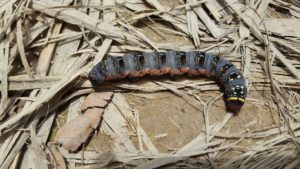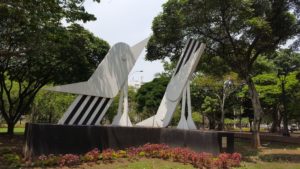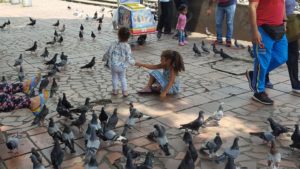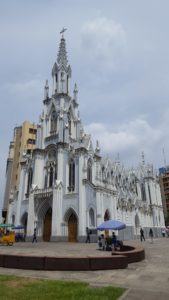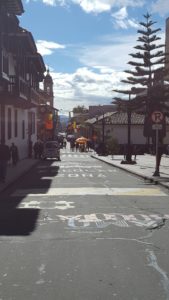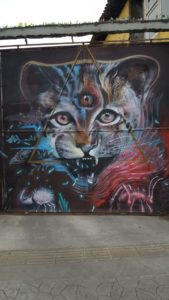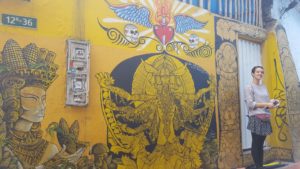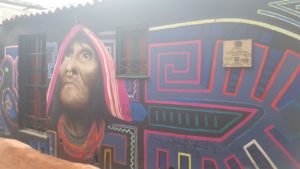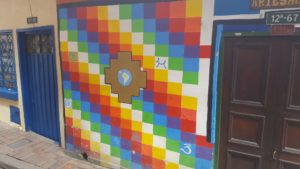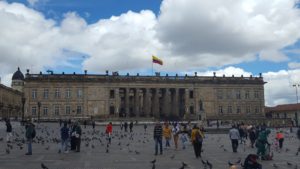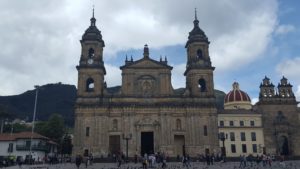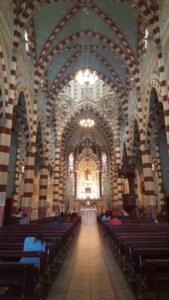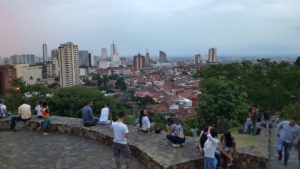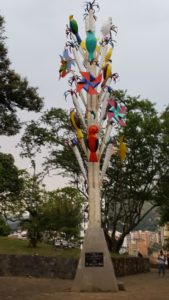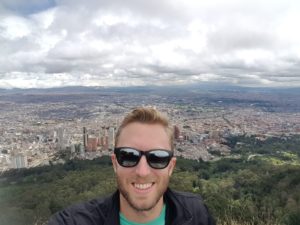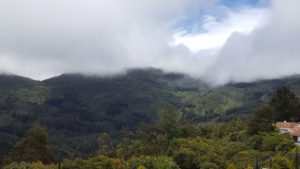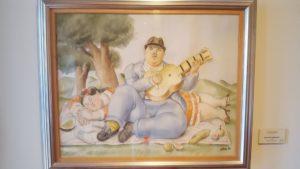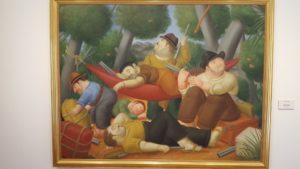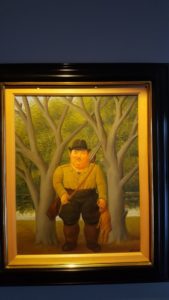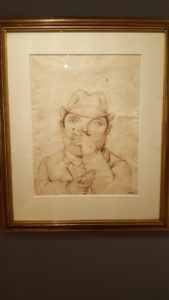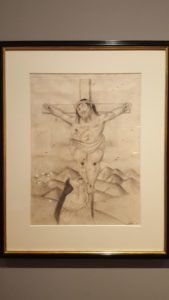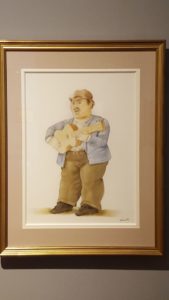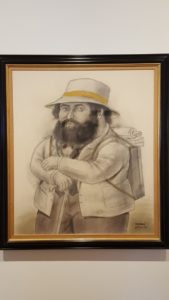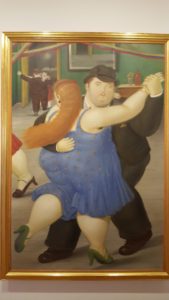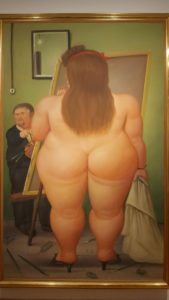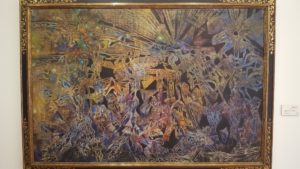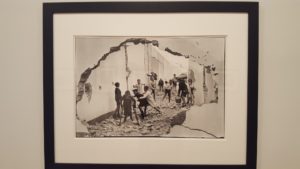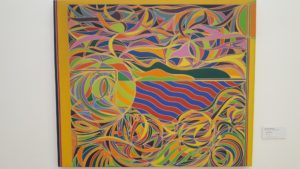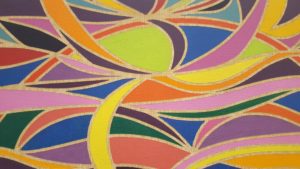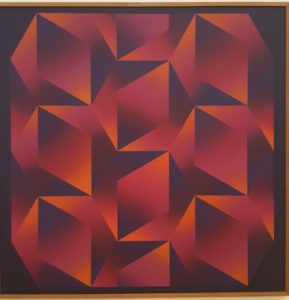
The bus from Armenia took a little under three hours and arrived at the bus terminal in Cali at about 3:15pm. I took a cab to Colombia House Hostel in barrio San Fernando.
Cali is the third largest city of Colombia. It is another city situated in a valley surrounded by carpeted green hills. Cali the capital of the Cauca provenance in southwestern Colombia, and lies approximately 100km east of the Pacific Ocean. Established by conquistadors in the 1500’s, it is another South American city with longstanding Spanish colonial heritage. Located near the equator, the climate is sunny and hot, but comfortable thanks to its mountain valley perch, throughout the year. It is dubbed ‘The Salsa Capital of the World.’ Indeed, spicy Afro-Caribbean beats and the unique dance style are ubiquitous throughout the city. Cali hosts world renowned salsa festivals and competitions, and dancers in flashy clothing can be found on the streets and in clubs putting on flamboyant, spectacular salsa shows for tourists and residents alike.
After checking in and getting settled, I headed out to explore the neighborhood. I walked down to Parque del Perro, and wandered the surrounding area. San Fernando is a lovely little enclave of Cali. There is a high density of modern restaurants, cafes, and bars serving upscale, healthy food. There were also several health food shops where I could find all my favorite alimentos sanos: cacao, organic herbs, turmeric, moringa, coconut oil, maca, kombucha, etc etc.
I paused for a late lunch of sushi in one of the cafes. Then I stopped in a health food store and supermarket, and spent way too much money on goodies for the road.
Back at the hostel, I participated in a free Salsa lesson on the patio with five other guests. I was suddenly transported back to my salsa lessons in Quito, Ecuador nine months prior, and reminded how awkward salsa is for a white boy. While most of the steps and moves are fairly easy to perform, the music moves at a fast tempo, and staying in rhythm constantly is quite a task. Then once you get the moves down, applying said moves, smoothly, with a partner is frustratingly difficult, almost discouraging. Having to keep my mind on my footwork and staying in-sync with the music and my partner feels like some sort of test and takes much of the fun out dancing salsa for me. Yet, like anything, learning is a process. Knowing that the goal is to get to where the body intuitively knows what to do, I pushed through my ineptitude hoping to construct sexy salsa neural pathways in my brain.
Colombians begin dancing salsa at family fiestas starting at about four years old, so it’s second nature to them. The Colombian salsa instructors couldn’t seem to comprehend how you’re not able to perform the steps in perfect rhythm. Several of the group salsa lessons I had were comical. With the salsa music pumping, the instructors just say, “No, no, no! No como eso. Como essttoo! (No no no! Not like that. Like thiisss!),” while continuing to dance and clapping their hands at you while providing no further instruction, as though their clapping will magically impart you with ten years of salsa experience.
And yet, in spite of all my suffering and struggling, I was still one of the best in the group during the free salsa lesson at the hostel. The others bumbled just as bad or worse than I did. The instructor, Mauricio, even had me demonstrate a couple of the moves I picked up faster than the others.
After salsa lessons, I went out to dinner with Rodolfo from the Netherlands. We watched the championship match of the Colombian soccer league, which was Cali versus Medellin. Cali lost 5-1, which was a great disappointment to the city of Cali. After the fourth goal, sounds of pained screams and bottles breaking erupted throughout the city. After the game, it was like a funeral in the city. A bunch of business seemed to close early, apparently to go home and mourn.
The next morning, I set out to explore the city, intending to hike Cerro Tres Cruces, a big hill with three crosses atop in the center of the city, in the process. On the way to the hill, I passed the El Estatua y Parque del Gato.

Tres Cruces proved to be more of a hike than I had anticipated. I tried to traverse the steep rocky terrain while wearing sandals and being without water or sunscreen in midday sun. I thought it was more of a pleasure hike. I decided to abandon the hike about 60% of the way to the top. “No vale la pena.”
I spent a while in Parque la Retreta, the central park of Cali, on the way home.
In the evening, I had another free salsa lesson at the hostel. That night, several hostel-folk planned to put our salsa lessons to use and go out dancing, but when rubber met the road, we were all tired and instead played a fun card game, “The Werewolf,” or “El Hombre Lobo,” for a couple of hours before turning in for bed.
The next day, I took another salsa lesson with Rodolfo and Maya from the UK. This time at a real salsa school. Great way to feel awkward, let me tell you. The class is two hours long. It starts out with an instructor in the front of the class that just starts dancing to blaring salsa music. You’re supposed to copy his steps and follow along, but of course that is extremely difficult because the instructor moves at breakneck speed with complete grace and expertise while most of the moves are new and difficult to a novice. Thus, Rudolfo, Maya, and myself spent most of that portion of the class flailing about, out-of-sync with the instructor and other experienced Colombian students. That part of the class lasted for 30 minutes, and all the gringos of class were happy when it ended and we broke down into groups for step-by-step instruction. The class fluctuated between being fun when I was doing well and arduous when I made a wrong step or otherwise got out of rhythm. It went by fast and was quite tiring.
In the evening, a group of hostel-folk gathered and went to La Topa, one of the three biggest and most popular salsa clubs in the city. When we first got there, I danced for a while with Maya. We used a bunch of the steps we’d learned in class that day. It was good because we’re both gringos with a similar level of skill.
After heading to the bar for a beer and shot with the guys in the group, by time I returned to the dancefloor, all the girls we’d come with were now dancing with Colombian guys whom were twirling them about with ease and bravado. I asked a couple Colombian girls to dance, and stumbled my way through a song with each of them. I couldn’t help but feel like they were thinking, “WTF is this gringo dooiiinng?!” while I was bumbling about and not leading properly. The other dudes I was hanging with had similar experiences. We mostly stood in the corner slamming beers while occasionally humiliating ourselves on the dancefloor for the rest of the night.
When our group decided to call it a night, the general sentiment of the girls was, “OMG that was so fun, I love dancing salsa!” For all the guys, “Ugh, salsa blows!” Nevertheless, it was still a good time, and I thought La Topa was a really cool, fun bar (excluding the fact you have to dance salsa (suavely) to pick up girls).
The next day, I went on a free walking tour in the historical center of Cali. The tour was lackluster, but I discovered the delicious drink of fresh pressed raw sugar cane juice, which I would buy from various street vendors over the next few days. Afterwards, I went out with Lillian from Switzerland, who I met on the tour, for a tea before returning to the hostel in the evening.
When I arrived, the daily free salsa lesson was taking place. I was kind of over salsa at that point, after feeling extremely white and incompetent the prior night, but it’s free so I got down anyways.
My bud Rodolfo and I went out to Sushi Green for an excellent dinner and a couple drinks to get the night started.
Later, we met up with a bunch of people from the hostel and then headed to a series of bars and clubs in the hip San Antonio part of town. It was a bit more familiar and comfortable hanging out in normal bars the whole night. At about 2am, I caught a cab home with several others while a few people in our group opted to go to a late-night club.
The next day, I said goodbye to everyone at Colombia House Hostel and headed to an Airbnb for a day of relaxation. To my delight, the building of my Airbnb had a sauna which I sat in for an hour to detox from the previous night. At noon, I ran some errands. I bought a sandwich and left it next to an indigente (homeless person) sleeping on the sidewalk. In the early afternoon, I started my Sunday poker session and ground out a small profit.
The next day, it was time to get a move on. I bought a bus ticket to Bogotá, but it was for an overnight trip leaving at 7pm. I spent the day idly, cooking myself in the sauna and spending the afternoon in a café and the bus station reading and writing while waiting to depart.
My bus arrived in Bogotá the following morning at about 8am. I collected my bags and caught a cab to Masaya Hostel in the heart of La Candelaria, the hip, happening neighborhood in old town Bogotá. I learned my bed wouldn’t be ready until 3pm (wtf?), so I had some 6+ hours to kill before I could settle in.
Bogotá is the capital and largest city of Colombia, home to some 9M people. It is located on a plateau high in the Andes 2600m above sea level in the south east of the country. As such it is rather cold, less than 60F, most of the day with mist and fog in the morning before a few hours of sunshine in the afternoon followed by brisk nights. More than just the political capital of the country, Bogotá is the capital of the country for nearly every major activity. Bogotá is the economic and industrial center of the country, home to skyscrapers and modern office buildings that are largely absent from the rest of the country. It is also home to the country’s biggest and most prestigious universities. It is also the unrivaled cultural and artistic center of the city, home to countless museums, art galleries, theatres, monuments, libraries, parks, stadiums, and venues. Bogotá is a very artistic place. There seemed to be more street artists in Bogotá than anywhere else I’ve been. A nice trait that I wish were more prevalent in the States.
I had breakfast and then headed to a free walking tour at 11am. The tour went all around the historic center, and showed us a lot of Bogotá’s graffiti. Bogotá is the second most graffitied city in the world, after only Berlin. It’s a pretty big thing there. Although I don’t like the term graffiti for what there is in Bogotá. To me graffiti signifies tagging, which can be artistic, but is usually just a name or initials in elaborate letters. On the other hand, Bogotá is covered in murals with historical and cultural themes.
After the tour, I went out to lunch with a few people from the tour and Claudia, our guide.
I returned to my hostel and my room was finally ready, which was good because I was ready for a siesta.
After my nap, I took a shower and headed out for dinner. There was a nice little hippy, vegetarian restaurant right next to my hostel. This place sold weed brownies, weed cookies, weed ice cream, weed soda, and weed tea. The waiters kept offering me weed products. I guess it seemed strange when I just ordered a curry dish and limonada de coco (fucking delicious drink common in Colombia that I don’t think I’ve mentioned until now, but I drank relentlessly).
The next morning, I set out to for Cerro Monserrate, a big hill on the northeastern edge of the city with a popular lookout and mini-pueblo atop. After getting lost on the way, it took me about 30 minutes to get to the foot of the hill, then another hour and fifteen minutes to hike up the rocky stairs to the top.
At the top was a church, several monuments, a market, and several dining shacks. The views over the city were nice, but there was quite a lot of people buzzing about. I snuck off, and found my way to my own private mirador and picnic spot looking out to the forested hills behind Bogotá.

On the hike down the mountain, I passed a boy of about 12 walking with his grandfather. The grandfather nudged the boy as I walked past, and the boy reluctantly greeted me in English. His family was having him tutored in English, and his grandpa wanted him to practice with me. I don’t think he’d ever spoken with a native English speaker before. Camillo was embarrassed when speaking with me at first. I reassured him and explained I know the feeling as I am learning Spanish. We walked down the hill together and chatted.
At the foot of the hill, I said goodbye. By that time, Camillo was smiling with a newfound confidence in his English and ability to successfully communicate with foreigners. His grandpa thanked me as we parted ways.
I found my way to a street market, and had a plato del día almuerzo for 6000 Pesos (~$2). Then I headed to Café Union. My type a place. It’s the type of café where they really take pride in the coffee, and actually include you in the coffee making process.
After getting properly caffeinated, I went over to check out the art museum, where they have Museo Botero, the Museo del Arte Moderno, and the Museo del Arte Classico all in connecting buildings. I really like Botero. His paintings just make me smile.
In the evening, I headed out for some fine dining. After all, Bogotá is the culinary capital of the country. I went to Capital Café y Cocina as recommended by the receptionist at my hostel. It didn’t disappoint. I had a steak sandwich, which was amazing. The beef was tender enough to cut with a spoon, and topped with some amazing homemade garlicy mayonnaise sauce.
The next day I spent plotting my next moves after Colombia. My 90-day Colombian visa was expiring in four days, so I had to get out of Dodge. The question was where to go next and how. Brazil, which borders Colombia not far from Bogotá, was out of the question because of their visa requirements and my lack of documentation to satisfy said requirements. Venezuela, next door, was also out of the question as it was experiencing hyperinflation and the downfall of its socialist government, riots and all. Ecuador is the other bordering country, but I’d already been there. The next logical step seemed to be Bolivia or Chile. Flights to both were ridiculously expensive. I found a flight into Lima, Peru the next day for less than $200 and jumped on it, planning to then take buses through the south of Peru, where I haven’t been, into Bolivia.
I was relieved once I had that all squared away. I hate planning. I just like to go.
I headed out to lunch at my favorite little street market for seis mil again. Then I headed to my favorite little café, Café Union, again. Then I headed to my favorite little art museum again.
In the evening, it was gourmet burgers at La Hamberguesa and two pints of craft beer at Bogotá Beer Company.
On the way home, I stopped to chat with a guy on the sidewalk painting abstract art. I’d seen this guy in the same spot on the side of the street every day, painting from sun up until the police told him to go home. This guy took time to explain to me the significance of each of his paintings hanging on display, and the theme of his current work. He was about 40 years old, seemed like he was destitute. I think his only possessions were the clothes on his back, canvas, paint, brushes, and his paintings. His paintings were on sale, but he didn’t even seem to care about selling them. He just wanted to paint. Paint for the sake of painting. Paint because he couldn’t live without painting. Though the guy had nothing, his passion for painting was inspiring. We should all be so lucky to be as passionate about anything as this dude was about painting.

The next day, I met Tomas from Holland while making breakfast in the kitchen of the hostel. We both had the same MO for the day: we were leaving Bogotá at night and had the day to kill. After we checked out of the hostel and put our bags into storage, we spent the day wandering the city together. We stopped for lunch, stopped at Café Union, stopped in a couple parks, stopped for beers, and just wandered the day away. Good times. Tomas is a super cool dude (seems like all Dutch are cool as fuck). Turned out, we shared a lot of common interests such as meditation, yoga, exploring consciousness, et cetera, so we had really deep, interesting conversations. Amazing how like attracts like.

At 6pm, I had a quick dinner at the vegetarian restaurant, again fighting off offers for weed brownies. Then I gathered my bags and called an Uber to the airport.
My flight was for 9:30pm, I was picked up three hours early, but it was still tight. Traffic was ridiculous and the ride to the airport was horribly slow. At the airport, I couldn’t find my airline to check in. After some help from a lovely police girl, I found Viva Colombia. I walked past it three times and somehow missed it in my frantic haste (something about Benjamin Franklin). I checked in, then had 35 minutes to get through security and customs. Luckily, the lines weren’t too long. But they were still slow. I convinced some people to let me cut at immigration, got through with a quick rubber stamp processing, and made it to my gate just as it my plane was boarding.
Sitting in the plane on the runway, I couldn’t believe I had somehow passed three months in Colombia. Time flies when you’re having fun, I guess. My mind relived my days. Cartagena partying with the boat crew and Arnold. Getting to know the city of Medellin. Spanish classes with Nathaly. Afternoons in cafes and parks. Nights out with lovely Colombian girls and my buddy Jason. Then my final 2.5 weeks touring the coffee triangle, Cali, and Bogotá. I became a little sentimental, and was sad to be leaving. For a country with such a checkered past and questionable reputation, I felt safe, comfortable, and was treated well my entire stay. The culture and way of life was always inviting and friendly, and the people were consummately lovely and helpful, if a little curious. I have nothing but good things to say about Colombia (well maybe the food leaves something to be desired :P), and can’t wait to come back. Viva Colombia!!!

